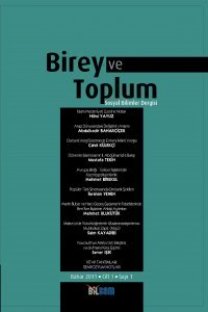FELDSTEİN-HORİOKA BULMACASI VE TÜRKİYE'DEN KANITLAR
Ülkelerin ekonomik büyümesinin artırılmasında yatırımların ve tasarrufların rolü büyüktür. Yatırımların kaynağının nereden sağlandığı konusu literatürde birçok başlıkla araştırılmıştır. Feldstein ve Horioka tasarruf ve yatırım ilişkisini uluslararası sermaye hareketleri çerçevesinde incelemiştir. Çalışmada sermaye hareketlerinin serbest olması durumunda yurtiçi tasarruflarla yatırım arasında düşük düzeyde bir ilişkinin olacağı vurgulanmıştır. Bu çalışmada Feldstein-Horioka bulmacası olarak literatürde geçen hipotezin varlığı Türkiye için araştırılmıştır. 1990-2019 yıllarını kapsayan çalışmada yapılan FMOLS-DOLS sonuçları doğrultusunda uluslararası tasarrufların yatırımları daha fazla etkilediği sonucuna ulaşılmıştır. Çalışmada yapılan Frekans Dağılım nedensellik analizi sonucunda tasarruf değişkeninden yatırıma doğru orta ve uzun dönemde bir ilişkinin olduğu, yatırım değişkeninden tasarruf değişkenine doğru ise orta dönemde bir ilişkinin olduğu belirlenmiştir.
Anahtar Kelimeler:
Tasarruf, yatırım, zaman serisi
THE PUZZLE OF THE FELDSTEIN-HORIOKA AND EVIDENCE FROM TURKEY
Investments and savings play an important role in improving the economic growth of countries. Where the source of the investments comes from has been examined within many titles in the literature. Feldstein and Horioka investigated the relationship between savings and investment within the framework of international capital mobility. They emphasized that there would be a low level relationship between domestic savings and investment if capital mobility were free, in the study. In this study the Feldstein- Horioka puzzle is tested for Turkey. In the FMOLS-DOLS results made in the study covering the years 1990-2019, it was concluded that international savings affect investments more. As a result of the Frequency Distribution causality analysis conducted in the study, it was determined that there is a medium and long-term relationship from the savings variable to the investment. In addition, it has been determined that there is a relationship between the investment variable and the savings variable in the medium term.
Keywords:
saving, invesment, time series,
___
- Abbott, A. J., & Vita, G. D. (2003). Another piece in the Feldstein—Horioka puzzle. Scottish Journal of Political Economy, 50(1), 69-89.
- Akay, E. Ç., & Türküz, E. (2016). Gelişmiş ve gelişmekte olan ülkelerde Feldstein-Horioka Bulmacasının analizi. EconWorld2016@ImperialCollege Proceedings 10-12 August, 2016; London, UK.
- Alakbarov, N., & Bayar, Y. (2021). International financial market integration and the Feldstein–Horioka Puzzle: Evidence from emerging market economies. Romanian Journal of Economic Forecasting, 24(1), 143.
- Aslan, A. (2009). Bütçe açığı sürdürülebilirliğinin dinamik analizi: Türkiye örneği. Maliye Dergisi, 157, 227-234.
- Ay, A. ve Özmen, I. (2017). Feldstein-Horioka hipotezinin yükselen ekonomilerde sınanması: panel veri analiz. Sosyal Ekonomik Araştırmalar Dergisi, 17, 1-18.
- Bangake, C., & Eggoh, J. C. (2011). The Feldstein–Horioka puzzle in African countries: A panel cointegration analysis. Economic Modelling, 28(3), 939-947.
- Bayat, T., Özcan, B. ve Taş, Ş. (2015), Türkiye’de döviz kuru geçiş etkisinin asimetrik nedensellik testleri ile analizi, Eskişehir Osmangazi Üniversitesi İİBF Dergisi, Cilt: 10, Sayı: 2, ss. 7- 30.
- Breitung, J. ve Candelon, B. (2006), Testing For Short and Long- Run Causality: A Frequency Domain Approach'', Journal of Econometrics, Cilt: 132, pp. 363- 378.
- Becker, R., Enders, W., & Lee, J. (2006). A stationarity test in the presence of an unknown number of smooth breaks. Journal of Time Series Analysis, 27(3), 381-409.
- Coakley, J., Fuertes, A. M., & Spagnolo, F. (2004). Is the Feldstein–Horioka puzzle history?. The Manchester School, 72(5), 569-590.
- Feldstein, M., & Horioka, C. (1979). Domestic savings and international capital flows (No. w0310). National Bureau of Economic Research. NBER Working Paper Series.
- Fouquau, J., Hurlin, C., & Rabaud, I. (2008). The Feldstein–Horioka Puzzle: A panel smooth transition regression approach. Economic Modelling, 25(2), 284-299.
- Karter, Ç. (2020). OECD ülkeleri Feldstein-Horioka hipotezi üzerine bir uygulama. Necmettin Erbakan Üniversitesi Sosyal Bilimler Enstitüsü İktisat Anabilim Dalı, Yayınlanmamış Doktora Tezi, Konya.
- Keskin, N. (2020). Yurtiçi tasarruflar İle yatırımlar arasındaki ilişki: Feldstein-Horioka hipotezi çerçevesinde Türkiye analizi. Yönetim ve Ekonomi Araştırmaları Dergisi, 18(1), 352-368.
- Ketenci, N. (2012). The Feldstein–Horioka Puzzle and structural breaks: Evidence from EU Members. Economic Modelling, 29(2), 262-270.
- Ketenci, N. (2018). Impact of the global financial crisis on the level of capital mobility in EU Members. Contemporary Research in Economics and Social Sciences, 2(2), 255-280.
- Konat, G., & Zeren, F. (2021). Is real gross domestic product (GDP) series stationary in EU countries? Evidence from the RALS-CIPS Test. Economics Bulletin, 41(3), 1813-1825.
- Kumar, S., Webber, D. J., & Fargher, S. (2012). Testing the validity of the Feldstein–Horioka puzzle for Australia. Applied Economics, 44(5), 599-605.
- Özek, Y. (2020). Türkiye ve Orta Asya Türk Cumhuriyetlerinde Feldstein-Horioka Bulmacasının test edilmesi. Bingöl Üniversitesi Sosyal Bilimler Enstitüsü Dergisi , (20), 489-508.
- Sachs, J. D. (1982). Aspects of the current account behavior of OECD Economies. NBER Working Paper, (w0859).
- Tsong, C. C., Lee, C. F., Tsai, L. J., & Hu, T. C. (2016). The fourier approximation and testing for the null of cointegration. Empirical Economics, 51(3), 1085-1113.
- Tunçsiper, B. (2016). Feldstein-Horioka Hipotezinin görünürde ilişkisiz regresyon yöntemiyle analizi: Gelişen Ekonomiler (E7) üzerine bir inceleme. Sosyal Ekonomik Araştırmalar Dergisi, 16(32), 16-25.
- Vamvakidis, M. A., & Wacziarg, R. (1998). Developing countries and the Feldstein-Horioka Puzzle. International Monetary Fund.
- Younis, S. J., & Dhannoon, M. A. (2020). Capital Mobility and the Feldstein–Horioka Puzzle: Re‐Examination of Arab Countries 1980-2018. Tanmiyat Al-Rafidain, 39(127), 9-23.
- ISSN: 2146-4634
- Yayın Aralığı: Yılda 2 Sayı
- Başlangıç: 2011
- Yayıncı: Bilgi Yolu Eğitim Kültür ve Sosyal Araştırmalar Merkezi: BİLSAM
Sayıdaki Diğer Makaleler
Mustafa AKSOĞAN, Oğuzhan ÖZDEMİR
DİNİ TEMELLİ ÇATIŞMALARIN BÖLGESEL GÜVENLİĞE ETKİLERİ: ARAKAN ÖRNEĞİ
SÜRDÜRÜLEBİLİR ÇEVRE ÖRNEĞİ: TÜRKİYE’DE YAVAŞ ŞEHİRLER (CİTTASLOW)
FELDSTEİN-HORİOKA BULMACASI VE TÜRKİYE'DEN KANITLAR
İHSÂU’L-ULÛM’UN YURTLANDIRICI ÇEVİRİSİNDEKİ ‘MANTIKSIZLIKLAR’ VE ‘İZ’ÂNSIZLIKLAR’ ÜZERİNE
ADANA’NIN MARKA ALGISI: METAFORİK BİR ANALİZ
Gökhan BAK, Yusuf NAZLI, Esen BİLGİLİ, İsmail GÜNDÜZ
MUHASEBE HATA VE HİLELERİ VE HİLELERİN ORTAYA ÇIKARILMASINDA ADLİ MUHASEBECİLİK MESLEĞİ
SSCB’DEN RUSYA FEDARASYONU’NA TÜRK-RUS İLİŞKİLERİ: İMKANLAR VE AÇMAZLAR
